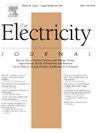FERC 应采取哪些措施实现跨地区电力传输
IF 2.2
Q1 Social Sciences
引用次数: 0
摘要
联邦能源管理委员会(FERC)于 2024 年 5 月 13 日发布了第 1920 号命令:"通过电力区域传输规划和成本分配建设未来"。这项长达 1363 页的命令酝酿多年,以之前的第 1000 号命令和其他命令为基础,被誉为促进美国电力传输发展的里程碑。在区域内输电规划这一传统概念的基础上,区域间输电规划带来了更多好处,包括降低生产(燃料)成本、改善发电能力共享、增加清洁能源供应、减少可再生能源削减,以及通过提供区域间输电支持提高可靠性和弹性。在过去两年中,国会提出了多项法案,涉及许可改革、区域间规划要求、最低区域间输电能力规定以及提供投资税收抵免等议题。虽然第 1920 号命令目前受到许多上诉和诉讼的影响,需要时间来解决,国会法案也仍有可能合并和通过,但这些都是区域间输电发展的积极信号。同时,作者在过去几年中一直与多家公用事业公司合作,致力于开发 "大草原电力"(PftP)区域间输电项目 (www.powerfromtheprairie.com)。虽然作者招募的这些公用事业公司是少数几家能够跳出其服务区域考虑潜在跨地区合作的公司,但仍然存在巨大的挑战和障碍。本文将联邦能源管理委员会第 1920 号命令和国会各项议案的内容与考虑进行区域间输电的公用事业公司的实际经验相结合。作者得出结论,除了 1920 号命令之外,联邦能源管理委员会还可以而且应该与国会和其他机构合作,为实现跨地区输电发展做出更多努力。作者提出了联邦能源管理委员会下一步可能采取的行动的 "路线图"。此外,还讨论了成立一个新实体的必要性,该实体应采取更全面的区域间输电规划观点,以克服当前的行业惰性。本文章由计算机程序翻译,如有差异,请以英文原文为准。
What FERC should do to enable interregional electric transmission
The Federal Energy Regulatory Commission (FERC) on May 13, 2024 issued its Order 1920: “Building for the Future Through Electric Regional Transmission Planning and Cost Allocation”. Years in the making and building on its previous Order 1000 and others, this 1363-page Order is being hailed as a landmark in promoting needed electric transmission development in the United States going forward. While establishing needed detailed requirements for transmission planning within regions, the Order stopped short of addressing interregional planning other than identifying issues related to it.
Expanding on the traditional concept of intraregional transmission planning, interregional planning offers advanced benefits including reduced production (fuel) costs, improved generation capacity sharing, increased clean energy supplies, reduced renewables curtailment, and improved reliability and resiliency by providing transmission support between regions.
On a parallel path, Congress has recently become very active in efforts related to encouraging interregional transmission. Multiple bills have been introduced the past two years, addressing permitting reform, requirements for interregional planning, specification of minimum interregional transfer capacity, and offering investment tax credits, among other topics. While Order 1920 is now subject to numerous appeals and lawsuits that will take time to be resolved, and the Congressional bills remain to be potentially combined and passed, these are all positive signs for interregional transmission development going forward.
Meanwhile, the authors have been engaged the past several years in working with multiple utilities toward development of the Power from the Prairie (PftP) interregional transmission project (www.powerfromtheprairie.com). While these utilities whom the authors recruited are a select few who can think outside their service territories toward potential interregional collaboration, significant challenges and obstacles still exist. These represent the real-world issues of whether interregional transmission can actually occur.
This article combines the content of FERC Order 1920 and the various Congressional bills with the on-the-ground experience with utilities thinking about doing interregional transmission. The authors conclude that there is much more FERC can and should do going beyond Order 1920, in concert with Congress and others, to enable interregional transmission development to happen. A “Road Map” of potential next actions by FERC is suggested. In addition, the need to form a new entity that takes a more holistic interregional transmission planning view to overcome current industry inertia is also discussed.
求助全文
通过发布文献求助,成功后即可免费获取论文全文。
去求助
来源期刊

Electricity Journal
Business, Management and Accounting-Business and International Management
CiteScore
5.80
自引率
0.00%
发文量
95
审稿时长
31 days
期刊介绍:
The Electricity Journal is the leading journal in electric power policy. The journal deals primarily with fuel diversity and the energy mix needed for optimal energy market performance, and therefore covers the full spectrum of energy, from coal, nuclear, natural gas and oil, to renewable energy sources including hydro, solar, geothermal and wind power. Recently, the journal has been publishing in emerging areas including energy storage, microgrid strategies, dynamic pricing, cyber security, climate change, cap and trade, distributed generation, net metering, transmission and generation market dynamics. The Electricity Journal aims to bring together the most thoughtful and influential thinkers globally from across industry, practitioners, government, policymakers and academia. The Editorial Advisory Board is comprised of electric industry thought leaders who have served as regulators, consultants, litigators, and market advocates. Their collective experience helps ensure that the most relevant and thought-provoking issues are presented to our readers, and helps navigate the emerging shape and design of the electricity/energy industry.
 求助内容:
求助内容: 应助结果提醒方式:
应助结果提醒方式:


